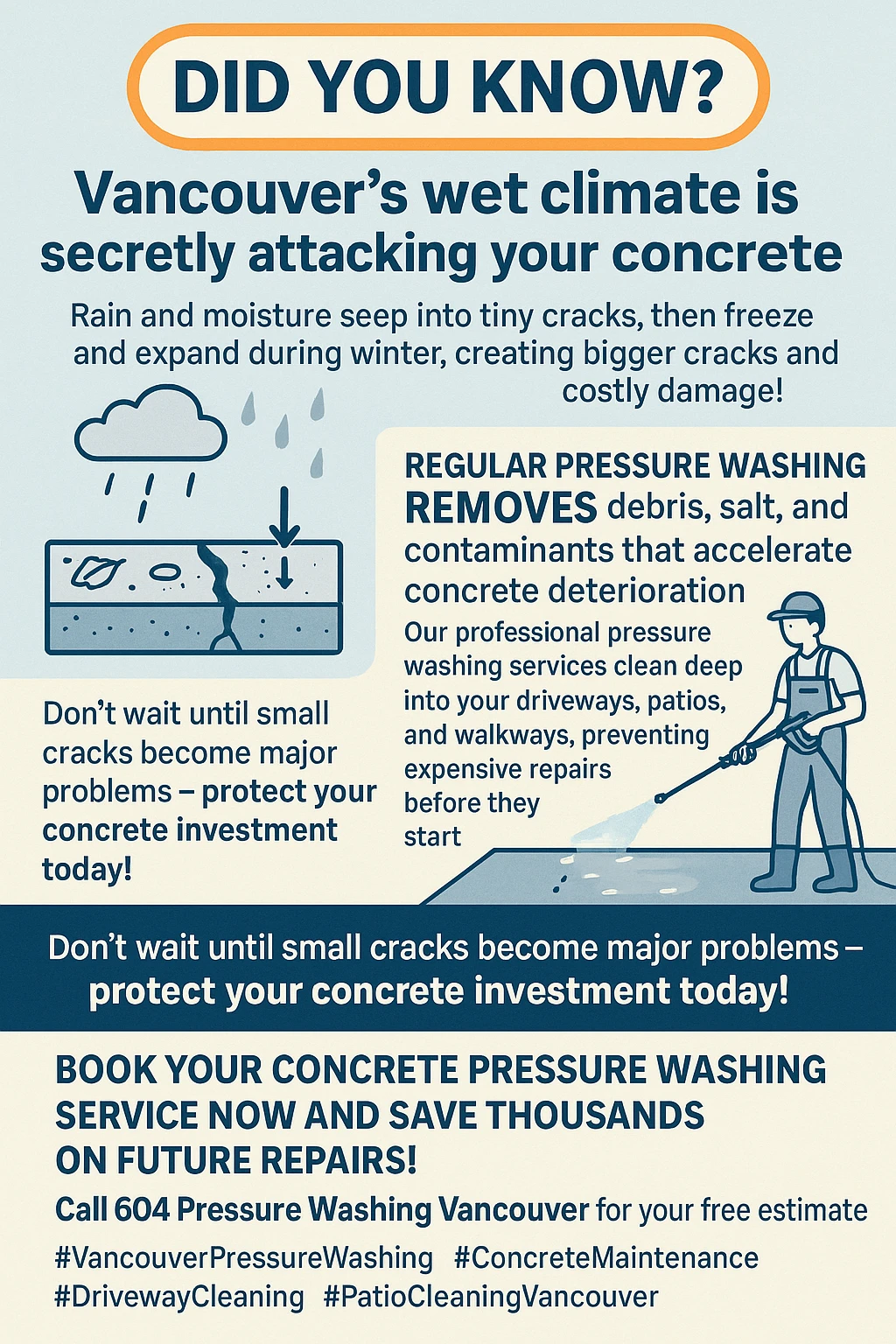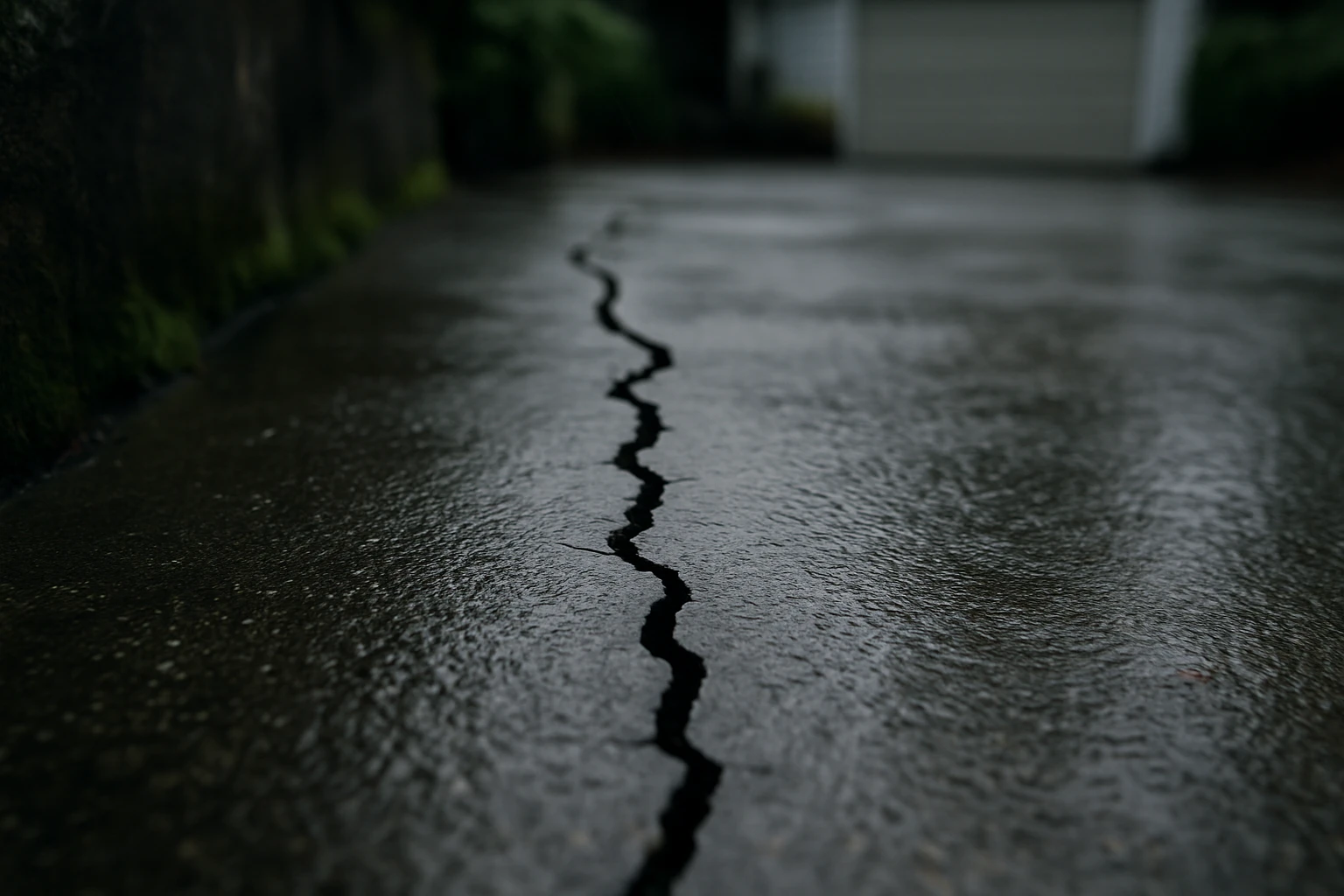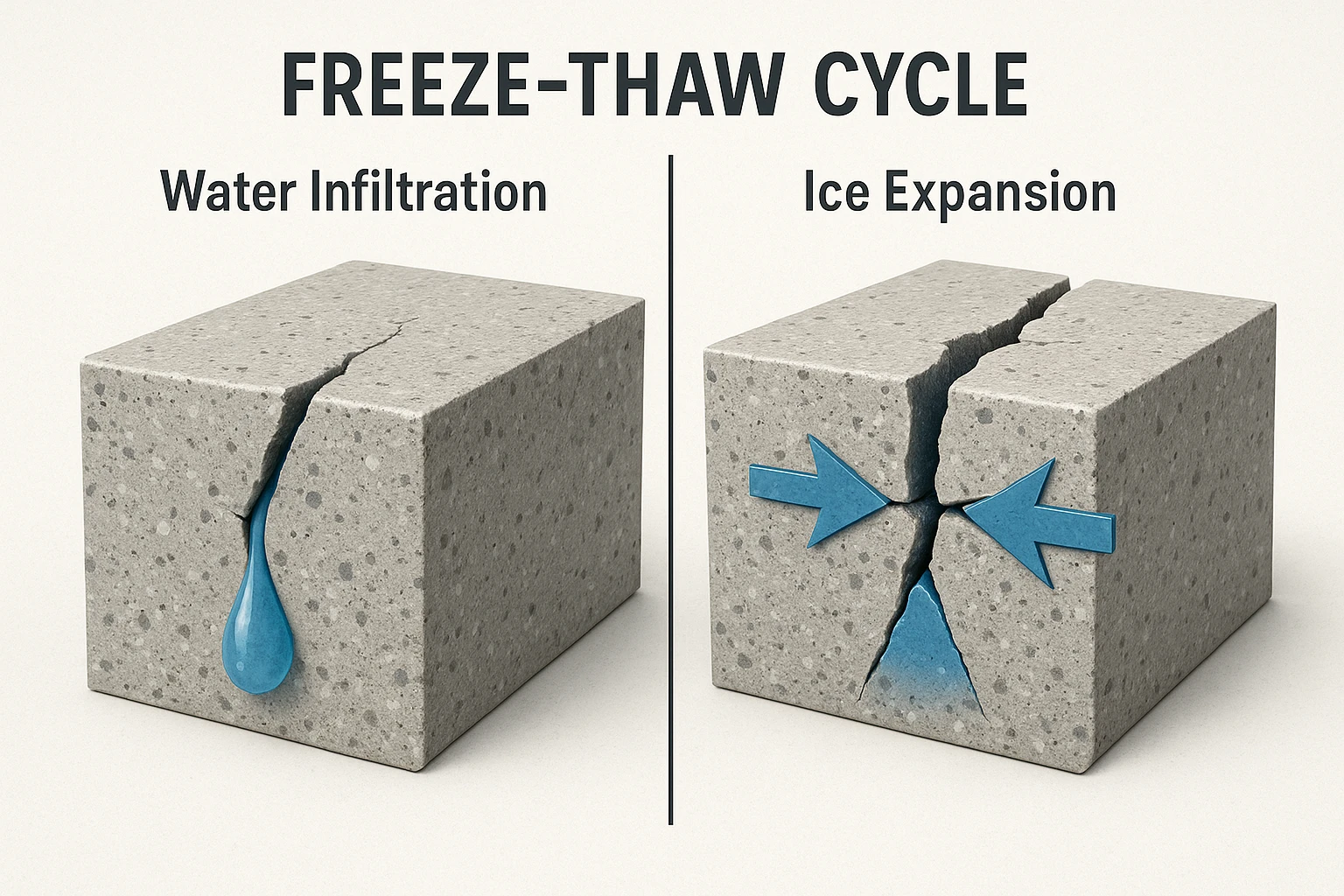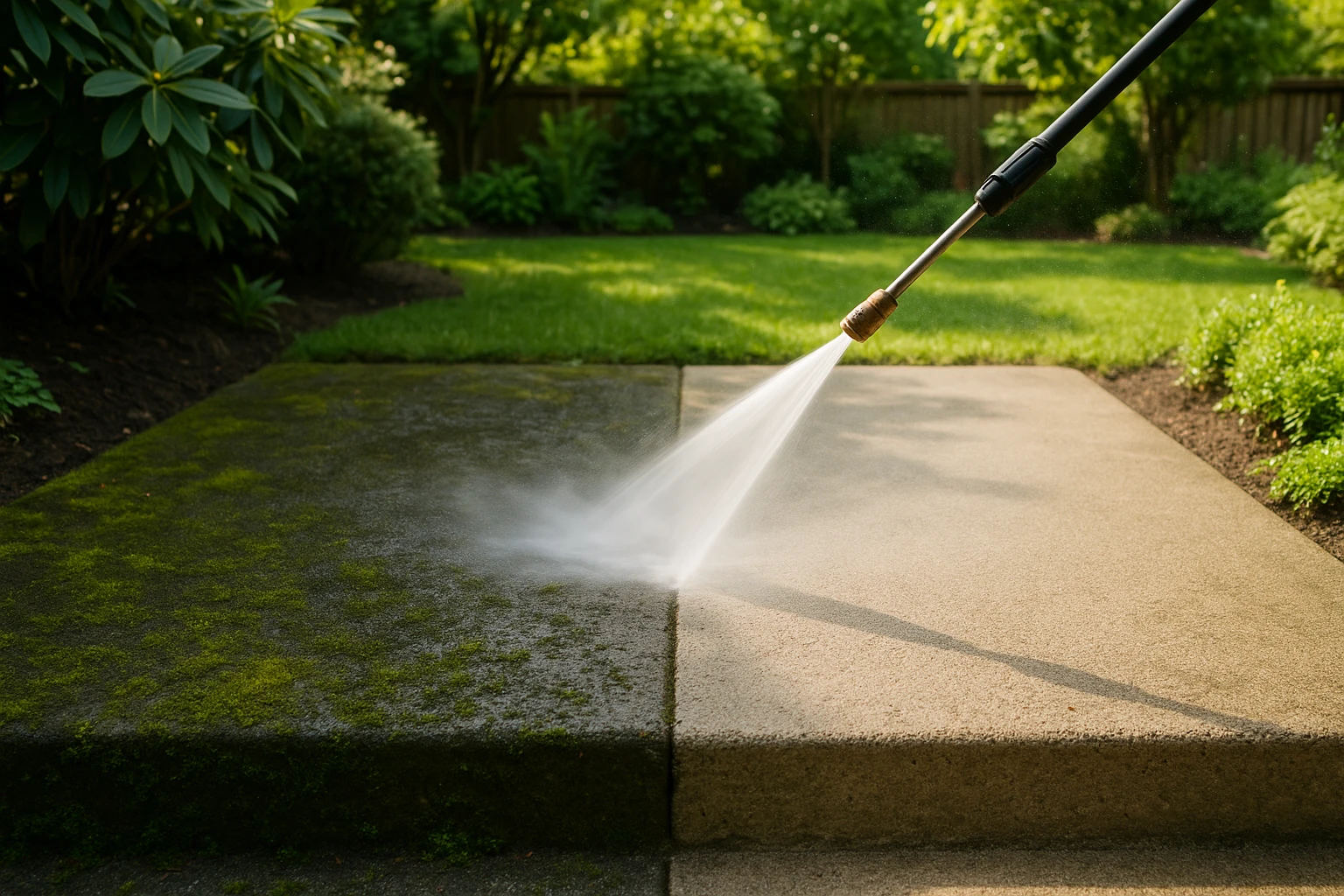Wondering why your Vancouver home’s concrete is showing those unsightly cracks and how pressure washing might be the secret weapon to prevent expensive repairs? Let’s dive into the real reasons behind concrete cracking in our rainy city and discover how a simple pressure washing routine can save you thousands down the road. Picture this: you’re sipping your morning coffee, gazing out at your beautiful Vancouver home, when suddenly you notice it – a hairline crack zigzagging across your driveway like a miniature earthquake fault line. My heart sank when I first spotted one on my own property last spring. That innocent-looking crack turned out to be the beginning of a $3,000 repair nightmare that could have been prevented with some simple maintenance. Here in Vancouver, where we get more rain than a weather forecaster’s worst nightmare, concrete cracking isn’t just common – it’s practically inevitable if you don’t stay on top of things. The truth is, concrete cracking in Vancouver homes happens for reasons that go way beyond normal wear and tear. Our unique climate, with its wet winters and occasional freeze-thaw cycles, creates the perfect storm for concrete damage. But here’s the kicker – most homeowners have no idea that regular pressure washing can actually help prevent these costly repairs before they spiral out of control. Understanding why concrete cracks in the first place is like solving a puzzle where moisture, soil conditions, and time all play starring roles. When you combine Vancouver’s notorious rainfall with the expansive clay soils common throughout the Lower Mainland, you’re basically asking your concrete to perform gymnastics it was never designed for. The good news? There’s a surprisingly simple maintenance routine that can help protect your investment and keep those repair bills at bay.
Key Outtakes:
- Vancouver’s wet climate and expansive clay soils create perfect conditions for concrete cracking through freeze-thaw cycles and hydrostatic pressure
- Regular pressure washing removes debris, salt, and organic matter that can accelerate concrete deterioration and crack formation
- Preventive maintenance through pressure washing costs a fraction of major concrete repairs, which can range from hundreds to thousands of dollars
- Proper drainage and moisture control, enhanced by pressure washing, significantly extends concrete lifespan in Vancouver’s challenging climate
- Early intervention through cleaning and sealing can prevent minor surface issues from becoming major structural problems

Understanding Concrete Cracking in Vancouver Homes
 Vancouver’s concrete cracking epidemic isn’t just bad luck – it’s a predictable result of our city’s unique environmental cocktail. When I started researching this topic after my own concrete disaster, I discovered that our Lower Mainland location creates a perfect storm of conditions that make concrete vulnerable. The combination of heavy rainfall, fluctuating temperatures, and the region’s notorious clay soils means that concrete structures face constant stress from multiple directions. The most common culprit behind concrete cracking in Vancouver homes is what experts call hydrostatic pressure. This fancy term basically means that water builds up around your foundation and concrete surfaces, pushing against them with relentless force. During our wet season, which let’s face it, feels like it lasts from October to June, water infiltration becomes a serious concern. When moisture seeps into tiny pores in concrete, it doesn’t just sit there passively – it actively works to break down the material from within. Another major factor that many homeowners don’t consider is soil movement. Vancouver’s clay-rich soils are particularly prone to expansion and contraction based on moisture content. When these soils get saturated during our rainy months, they swell up like a sponge, putting immense pressure on concrete foundations and slabs. Then, during drier periods, the soil contracts, leaving concrete unsupported and vulnerable to settling and cracking. It’s like your concrete is constantly riding an invisible roller coaster of ground movement.
Vancouver’s concrete cracking epidemic isn’t just bad luck – it’s a predictable result of our city’s unique environmental cocktail. When I started researching this topic after my own concrete disaster, I discovered that our Lower Mainland location creates a perfect storm of conditions that make concrete vulnerable. The combination of heavy rainfall, fluctuating temperatures, and the region’s notorious clay soils means that concrete structures face constant stress from multiple directions. The most common culprit behind concrete cracking in Vancouver homes is what experts call hydrostatic pressure. This fancy term basically means that water builds up around your foundation and concrete surfaces, pushing against them with relentless force. During our wet season, which let’s face it, feels like it lasts from October to June, water infiltration becomes a serious concern. When moisture seeps into tiny pores in concrete, it doesn’t just sit there passively – it actively works to break down the material from within. Another major factor that many homeowners don’t consider is soil movement. Vancouver’s clay-rich soils are particularly prone to expansion and contraction based on moisture content. When these soils get saturated during our rainy months, they swell up like a sponge, putting immense pressure on concrete foundations and slabs. Then, during drier periods, the soil contracts, leaving concrete unsupported and vulnerable to settling and cracking. It’s like your concrete is constantly riding an invisible roller coaster of ground movement.
The Hidden Dangers of Neglected Concrete Maintenance
 Most Vancouver homeowners treat concrete like it’s indestructible, but that couldn’t be further from the truth. What starts as a hairline crack can quickly escalate into a major structural issue if left unchecked. I learned this lesson the hard way when a small crack in my driveway turned into a spider web of damage over just one winter season. The freeze-thaw cycles that occasionally hit our region are particularly brutal on compromised concrete. When water gets into concrete cracks and freezes, it expands with incredible force – we’re talking about pressures that can exceed 25,000 pounds per square foot. This expansion pushes the crack wider, allowing even more water to infiltrate during the next rainfall. It’s a vicious cycle that accelerates exponentially once it starts. What might begin as a barely visible surface crack can transform into a major structural problem within a single season if conditions are right. The financial implications of neglected concrete maintenance are staggering. Foundation crack repairs in Vancouver typically range from $500 to $3,000 per crack, depending on the severity and location. But here’s where it gets really expensive – if water infiltration leads to basement flooding or structural damage, you’re looking at repair bills that can easily climb into the tens of thousands. I’ve seen neighbors deal with mold remediation, structural reinforcement, and complete concrete replacement because they ignored early warning signs. Beyond the immediate repair costs, damaged concrete can significantly impact your property value. Home inspectors are trained to identify concrete issues, and potential buyers often see cracks as red flags indicating poor maintenance or potential structural problems. Even minor cosmetic cracks can knock thousands off your home’s selling price, making preventive maintenance not just smart but financially essential. The health implications are another often-overlooked consequence of concrete problems. Cracks in foundation walls can allow moisture infiltration, creating ideal conditions for mold and mildew growth. Vancouver’s already humid climate means that any additional moisture intrusion can quickly lead to indoor air quality issues. I’ve talked to homeowners who developed respiratory problems directly linked to moisture issues that started with simple concrete cracks.
Most Vancouver homeowners treat concrete like it’s indestructible, but that couldn’t be further from the truth. What starts as a hairline crack can quickly escalate into a major structural issue if left unchecked. I learned this lesson the hard way when a small crack in my driveway turned into a spider web of damage over just one winter season. The freeze-thaw cycles that occasionally hit our region are particularly brutal on compromised concrete. When water gets into concrete cracks and freezes, it expands with incredible force – we’re talking about pressures that can exceed 25,000 pounds per square foot. This expansion pushes the crack wider, allowing even more water to infiltrate during the next rainfall. It’s a vicious cycle that accelerates exponentially once it starts. What might begin as a barely visible surface crack can transform into a major structural problem within a single season if conditions are right. The financial implications of neglected concrete maintenance are staggering. Foundation crack repairs in Vancouver typically range from $500 to $3,000 per crack, depending on the severity and location. But here’s where it gets really expensive – if water infiltration leads to basement flooding or structural damage, you’re looking at repair bills that can easily climb into the tens of thousands. I’ve seen neighbors deal with mold remediation, structural reinforcement, and complete concrete replacement because they ignored early warning signs. Beyond the immediate repair costs, damaged concrete can significantly impact your property value. Home inspectors are trained to identify concrete issues, and potential buyers often see cracks as red flags indicating poor maintenance or potential structural problems. Even minor cosmetic cracks can knock thousands off your home’s selling price, making preventive maintenance not just smart but financially essential. The health implications are another often-overlooked consequence of concrete problems. Cracks in foundation walls can allow moisture infiltration, creating ideal conditions for mold and mildew growth. Vancouver’s already humid climate means that any additional moisture intrusion can quickly lead to indoor air quality issues. I’ve talked to homeowners who developed respiratory problems directly linked to moisture issues that started with simple concrete cracks.
How Pressure Washing Prevents Concrete Damage
 Now here’s where pressure washing becomes your concrete’s best friend, and honestly, I wish I’d known this earlier. Regular pressure washing does so much more than just make your concrete look pretty – it’s actually a crucial preventive maintenance technique that can significantly extend your concrete’s lifespan. The key is understanding how pressure washing addresses the root causes of concrete deterioration before they become expensive problems. The primary benefit of pressure washing is debris removal, which might sound simple but is actually incredibly important for concrete health. Over time, leaves, dirt, moss, and other organic matter accumulate in the tiny pores and surface irregularities of concrete. This organic material retains moisture like a sponge, creating consistently damp conditions that accelerate concrete degradation. When you pressure wash regularly, you’re essentially removing this moisture-trapping layer and giving your concrete a chance to dry out properly. Salt damage is another major concern for Vancouver concrete, especially during winter months when road salt and de-icing chemicals get tracked onto driveways and walkways. These chemicals are incredibly corrosive to concrete, gradually breaking down the surface and creating pathways for water infiltration. Regular pressure washing removes salt residue before it can cause permanent damage. I make it a point to pressure wash my driveway and walkways at least once after winter ends, specifically to remove any salt buildup. One of the most overlooked benefits of pressure washing is its ability to reveal early signs of concrete problems. When you’re out there cleaning your concrete surfaces, you naturally become more familiar with their condition. You’ll notice new cracks, surface irregularities, or areas where water isn’t draining properly. This early detection is invaluable because it allows you to address small issues before they become major problems. Think of it as a regular health check-up for your concrete.
Now here’s where pressure washing becomes your concrete’s best friend, and honestly, I wish I’d known this earlier. Regular pressure washing does so much more than just make your concrete look pretty – it’s actually a crucial preventive maintenance technique that can significantly extend your concrete’s lifespan. The key is understanding how pressure washing addresses the root causes of concrete deterioration before they become expensive problems. The primary benefit of pressure washing is debris removal, which might sound simple but is actually incredibly important for concrete health. Over time, leaves, dirt, moss, and other organic matter accumulate in the tiny pores and surface irregularities of concrete. This organic material retains moisture like a sponge, creating consistently damp conditions that accelerate concrete degradation. When you pressure wash regularly, you’re essentially removing this moisture-trapping layer and giving your concrete a chance to dry out properly. Salt damage is another major concern for Vancouver concrete, especially during winter months when road salt and de-icing chemicals get tracked onto driveways and walkways. These chemicals are incredibly corrosive to concrete, gradually breaking down the surface and creating pathways for water infiltration. Regular pressure washing removes salt residue before it can cause permanent damage. I make it a point to pressure wash my driveway and walkways at least once after winter ends, specifically to remove any salt buildup. One of the most overlooked benefits of pressure washing is its ability to reveal early signs of concrete problems. When you’re out there cleaning your concrete surfaces, you naturally become more familiar with their condition. You’ll notice new cracks, surface irregularities, or areas where water isn’t draining properly. This early detection is invaluable because it allows you to address small issues before they become major problems. Think of it as a regular health check-up for your concrete.
The Science Behind Pressure Washing Protection
Pressure washing works on multiple levels to protect concrete from Vancouver’s challenging environment. The high-pressure water effectively removes not just surface dirt but also penetrates into the concrete’s pores, flushing out contaminants that could cause long-term damage. This deep cleaning action is particularly important in our climate where moisture and organic matter can quickly establish themselves in concrete surfaces. The mechanical action of pressure washing also helps maintain concrete’s surface texture, which is crucial for proper drainage. Over time, concrete surfaces can become glazed or sealed by accumulated dirt and organic matter, creating areas where water pools instead of draining away. By regularly pressure washing, you’re maintaining the concrete’s natural texture and ensuring that water can flow off the surface rather than standing and potentially infiltrating cracks. Another often-overlooked benefit is how pressure washing can help maintain the effectiveness of concrete sealers. Many Vancouver homeowners invest in concrete sealing as a protective measure, but these sealers can only work effectively on clean surfaces. Regular pressure washing removes the buildup that can prevent sealers from adhering properly, ensuring that your protective treatments remain effective for their intended lifespan.
Implementing an Effective Pressure Washing Maintenance Schedule
Creating a pressure washing maintenance schedule for your Vancouver home requires understanding both seasonal factors and the specific needs of different concrete surfaces. Based on my experience and conversations with local contractors, I’ve developed a system that maximizes protection while being realistic about Vancouver’s weather patterns and homeowner schedules. The ideal pressure washing schedule for Vancouver homes involves at least three targeted sessions per year, timed to address specific seasonal challenges. Spring cleaning should focus on removing winter salt residue and organic matter that accumulated during the wet season. This is also the perfect time to assess any damage that occurred during winter freeze-thaw cycles and address minor issues before they worsen. Summer maintenance is crucial for moss and algae control, which can be particularly problematic in Vancouver’s humid climate. During this session, pay special attention to shaded areas and north-facing surfaces where moisture tends to linger. I’ve found that a mid-summer pressure washing session, combined with a mild concrete cleaner, can prevent the organic growth that would otherwise create moisture-retention problems throughout the year. Fall preparation is perhaps the most important session, as it removes leaves, debris, and organic matter that would otherwise decompose over winter and create acidic conditions harmful to concrete. This pre-winter cleaning also allows you to apply concrete sealers or protective treatments that will help your surfaces survive the wet season in better condition.
Equipment and Technique Considerations
Choosing the right pressure washing equipment and techniques is crucial for concrete protection rather than damage. Not all pressure washers are created equal, and using the wrong settings can actually cause more harm than good. For concrete surfaces, I recommend using equipment with adjustable pressure settings and starting with lower pressures to assess the concrete’s condition. The proper technique involves maintaining appropriate distance from the concrete surface – typically 12 to 18 inches for most residential applications. Working in systematic patterns ensures even cleaning while preventing the streaking that can occur with random spraying patterns. It’s also important to recognize when professional help might be needed, especially for surfaces showing signs of structural damage or for areas around sensitive foundation elements. Water temperature and cleaning solutions also play important roles in effective concrete maintenance. While cold water is sufficient for basic cleaning, heated water can be more effective for removing stubborn stains and organic growth. Adding appropriate concrete cleaners can enhance the cleaning process, but it’s crucial to choose products that won’t damage the concrete or harm surrounding vegetation.
Frequently Asked Questions
Can pressure washing actually damage concrete surfaces?
Yes, pressure washing can damage concrete if done incorrectly, but proper technique makes it safe and beneficial. The key is using appropriate pressure settings and maintaining proper distance from the surface. Most residential concrete can safely handle pressures between 1,500 and 3,000 PSI when applied correctly. Start with lower pressure and gradually increase if needed, always keeping the nozzle moving to prevent concentrated damage to any single area. Older concrete or surfaces already showing signs of deterioration require extra care. If you notice loose aggregate or surface scaling, reduce pressure significantly and consider professional assessment. The goal is thorough cleaning without mechanical damage, which is entirely achievable with proper equipment and technique.
How often should I pressure wash my concrete to prevent cracking?
For Vancouver homes, I recommend pressure washing concrete surfaces at least twice per year, with additional cleaning as needed based on specific conditions. Spring and fall are the most important times, addressing winter damage and preparing for wet season respectively. High-traffic areas like driveways and walkways may benefit from more frequent cleaning, especially during moss and algae season. The frequency also depends on your property’s specific conditions. Homes with significant tree coverage or north-facing surfaces may need more frequent cleaning to prevent organic growth. Similarly, properties near busy roads may accumulate salt and debris faster, requiring additional maintenance sessions. Pay attention to your concrete’s condition and adjust your schedule accordingly.
What’s the connection between proper drainage and concrete longevity?
Proper drainage is absolutely critical for concrete longevity in Vancouver’s wet climate. When water can’t drain away from concrete surfaces effectively, it creates the hydrostatic pressure that leads to cracking and structural damage. Pressure washing helps maintain proper drainage by removing debris from drainage channels and maintaining the surface texture that allows water to flow away rather than pooling.
Clogged drainage systems can cause water to back up against foundations and concrete slabs, creating the exact conditions that lead to expensive repairs. Regular pressure washing of drainage areas, combined with proper grading and maintenance, ensures that Vancouver’s heavy rainfall doesn’t become a threat to your concrete structures. This preventive approach is far more cost-effective than dealing with drainage-related concrete damage after it occurs.
Wrapping Up
Taking care of your Vancouver home’s concrete doesn’t have to be a source of stress or surprise expenses. Throughout this journey of understanding concrete cracking and prevention, the message is clear: regular maintenance through pressure washing is one of the most cost-effective investments you can make in your property. The combination of our challenging climate, expansive soils, and heavy rainfall creates conditions where concrete problems are inevitable – unless you take proactive steps to prevent them. The beauty of pressure washing as a preventive measure lies in its simplicity and effectiveness. For the cost of a few hours of work or a professional service call, you can potentially save thousands in repair costs while extending your concrete’s lifespan significantly. The key is consistency and understanding that this isn’t just about aesthetics – it’s about protecting one of your home’s most important structural elements from Vancouver’s unique environmental challenges. Remember that concrete maintenance is an investment in your property’s long-term value and your family’s safety. Those hairline cracks that seem insignificant today can become major structural issues tomorrow if left unchecked. By implementing a regular pressure washing schedule and staying vigilant about early signs of concrete problems, you’re not just maintaining your home – you’re protecting your investment and ensuring peace of mind for years to come.

